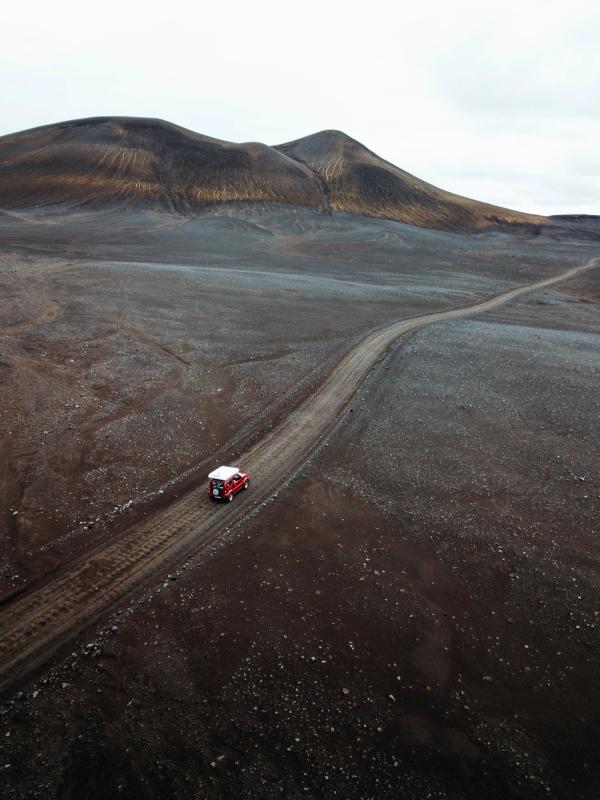
Top 5 Must-Visit Destinations in the Icelandic Highlands
Embark on an extraordinary expedition through the rugged beauty of the Icelandic Highlands, where the freedom and flexibility of camper van rentals in Iceland become the key to unlocking the region's hidden treasures.
The central plateau of Iceland is one of the wildest places on earth. Known as the highlands, the large expanses of uninhabitable desert, mountain ranges, deep valleys, and glaciers are traversed by only a few select routes. These rough tracks, the F-Roads, will take you through some of the most epic scenery you’ll ever see, and with careful planning and preparation, a tour of the highlands might be the best trip you’ll ever undertake.
There are plenty of great places to visit in the Highlands, but we’ve chosen the five best locations in the region.
To get there, you’ll need a 4x4—there’s no other way if you’re planning on doing some highland travel. Go Campers has the best 4x4 camper rental in Iceland, so don’t hesitate to reserve yours now.
1. Landmannalaugar
There’s rarely been a time when people talking about the highlands haven’t at least mentioned Landmannalaugar. Perhaps the most well-known of all the highland locations, this is a favorite with locals and tourists alike for its unreal hiking. The rhyolite mountains are one of the most popular features, changing hues as the light does, but in a close second place is the large natural hot spring right next to the campsite and sprawling lava field. Being relatively easy to access means this location is also the busiest of the highland destinations, but that doesn’t make it any less special.
There are plenty of great hiking trails here, both short and long, and of course, this is the official starting point for the Laugavegur trail, taking you across the southern highlands back down towards Thórsmörk before finishing at Skogafoss.
How to get to Landmannalaugar
Looking at a map, you can probably see that many F-roads lead to Landmannalaugar: F208 from the north, F208 from the south, and F225 from the west. The easiest route to take with the least risk is the F208 from the north, turning off F26. This is the route that the buses take, and there are no river crossings except for the one at the very end.
Even if you reach this point, you can park your 4x4 and walk across a small footbridge into the reserve. F225 from the west is a more scenic route into the reserve but contains several river crossings – if you’re not experienced or comfortable crossing rivers, we wouldn’t recommend this route. Finally, coming into Landmannalaugar from the south is the riskiest. The track is very rough and crosses many rivers, many of which are quite deep.
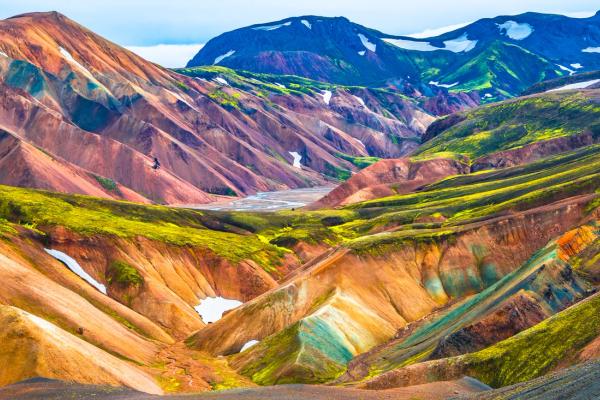
Can you get to Landmannalaugar Without a 4x4?
If you’re excited to explore Landmannalaugar but you don’t have a 4x4, don’t worry. Daytrips leave from both Reykjavik and Vik, taking all the stress out of trying to tackle the F-Roads and river crossings yourself. There’s also the possibility of catching the Landmannalaugar bus. You can reserve tickets online and leave your campervan at the campsite in Hella.
Accommodation Options in Landmannalaugar
There’s no Landmannalaugar hotel here – accommodation is just a campsite. There’s no need to reserve your spot – park your car or pitch your tent wherever there’s space. Also available on site is sleeping bag space in the Landmannalaugar hut, which comes with the use of an indoor kitchen. To do this, reserve your spot ahead of time.
2. Thórsmörk
Translated as ‘Thor’s Wood,’ Thórsmörk is a magical place to visit in the highlands. Although quite tricky to get to (there are multiple river crossings where the water can often be running quite high), if the conditions are good and you can make it into this gorgeous valley, you’ll be rewarded with one of the most serene and vibrant locations in all of Iceland. Mountain peaks provide views over crisscrossing glacial rivers, and lush green gorges hide away a small population of Arctic foxes. This is often the favorite location of those who can get here.
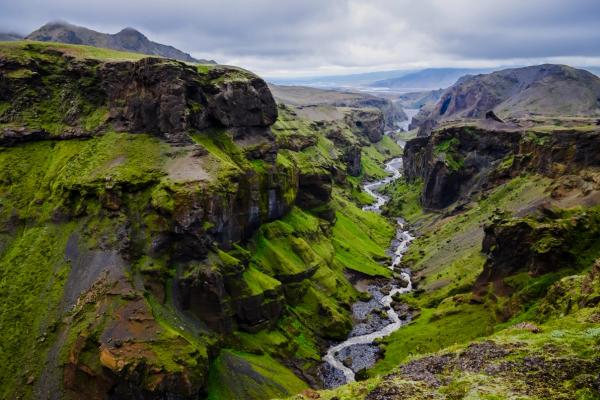
How to get to Thórsmörk
F249 is the road that takes you toward Thórsmörk, a very beautiful route with many exciting and adventurous river crossings. However, there’s one river at the very end that you shouldn’t attempt to cross at all: the Krossá River. There are a few footbridges set up across this river (the location of these are moved depending on the river flow) so that you can walk your way into the nature reserve.
Can you get to Thórsmörk Without a 4x4?
Again, there are plenty of tour companies that offer day trips into the area. Another option is to hike across the Fimmvörðurháls pass from Skogafoss, which can either be done in one day or split up into two days with an overnight stay at the Fimmvörðurháls Hut. For those without a 4x4, you should park your campervan at the Lava Centre in Hvolsvöllur and reserve your spot on the bus, which will pick you up from that location.
Accommodation Options in Thórsmörk
The Volcano Huts are the only accommodation option in Thórsmörk. They offer camping, private bedrooms, small cottages, dormitories, and even glamping.
3. Kerlingarfjöll
Kerlingarfjöll is a mountain range in the central highlands in the shadow of the Hofsjökull glacier. The mountains are rich in minerals, which come to the surface and tinge the terrain a rusty orange, contrasting with the white snow on top. Steam rises from the ground in places; the entire reserve is part of an active volcano system, so expect plenty of special geothermal landscapes and hot spring areas. Hiking is the game's name here as well, with countless marked and unmarked trails crisscrossing across the area, scaling mountains, and delving into valleys.
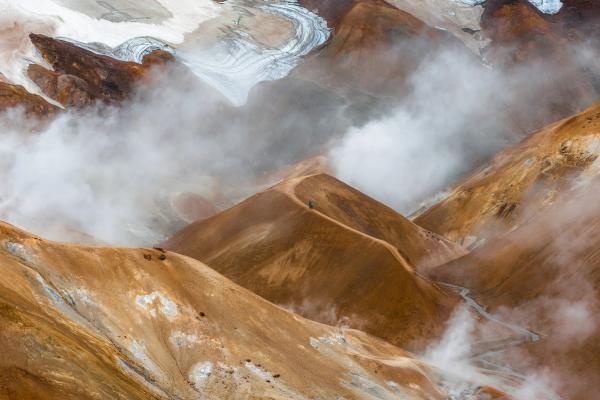
How to get to Kerlingarfjöll
F35 is the road that takes you toward Kerlingarfjöll, branching north just after Gullfoss on the Golden Circle route. Taking you between the two glaciers, Hofsjökull and Langjökull, the views are spectacular. You’ll eventually follow signs onto F347 that take you towards the mountain range – there are two unbridged streams to cross, one shallow and one deep.
Accommodation Options in Kerlingarfjöll
If you’re planning on staying a night or two here, the Kerlingarfjöll Mountain Resort is the one and only option. They have a hotel with 20 rooms, private chalets, sleeping bag accommodation in chalets, and a large campsite. For those staying in the sleeping bag accommodation and campsite, there are cooking facilities available as well. There’s also a restaurant on site.
4. Askja
Dramatic landscapes molded over millennia by violent volcanoes, eerily blue water in a crater, and snow-capped peaks eroding under the biting winds blowing down from the nearby Vatnajökull glacier; Askja is one of the least inhabitable spots in all of Iceland, if not the world. It’s also one of the most exciting places to visit in the Icelandic highlands.
This volcanic caldera sits north of Vatnajökull glacier and has had many eruptions over its time, both large and small. This is also where the Apollo 11 astronauts trained before heading toward the moon, thanks to the lunar-like landscapes.
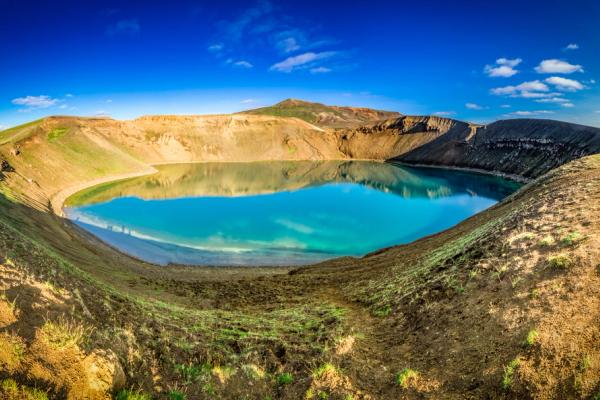
How to Get to Askja
This area is best accessed by heading south along F905 and then linking onto F910. You’ll eventually reach a mountain hut called Dreki, the only accommodation near Askja. It’s advisable to get out here and chat with the staff at the mountain hut to ascertain the conditions of the road ahead, F894, which takes you all the way to the crater and lake.
The other route that you might see, the F88, has a couple of rivers that can’t be forded with a regular 4x4. It’s not recommended at all to take this route, so don’t attempt it.
Accommodation Options Near Askja
As mentioned above, the mountain hut Dreki, which is closest to A, offers sleeping bag space and a campsite. We also recommend staying at one of the campsites near Lake Myvatn.
5. Laki and Lakagígar
In 1783, the volcano Laki had a massive violent eruption that wiped out 25% of the population of Iceland. It was one of the most devastating eruptions in history, spewing forth poisonous ash that caused famine across Europe and the rest of the world. You can visit the mountain, which looks much like any other in Iceland. But Lakagígar is the real attraction here. A giant row of craters caused by this eruption is a powerful reminder of the destruction caused all those years ago.
Twisted black lava formations are now covered in soft green moss, belying the power that once resided in this dormant volcano. Nowhere else in Iceland is there such a prevalence of green moss, so stick to the tracks and tread carefully.
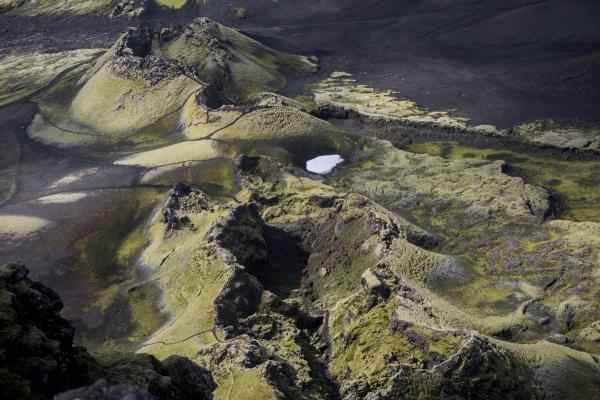
How to Get to Lakagígar
F206 is the road you want to take to get to this area, but be warned: this is one of, if not the most challenging road in the highlands. The road is extremely rough, and the rivers are deep and easily swell after rainfall, making them too dangerous to cross. We can’t stress enough that only experienced drivers try to tackle this road with at least two vehicles in a convoy, and even then, always keep an eye on the conditions.
You’ll eventually reach Laki. Further on, the road will turn into F207, which loops past Lakagígar and back down towards F206 again.
Alternatively, you can reserve your spot on the bus (https://www.nat.is/bus-schedule-klaustur-laki/) that leaves from Kirkjubæjarklaustur.
Accommodation Options Near Lakagígar
The Blágil Hut & Campsite is the nearest option for staying overnight, as it’s on F207.
Conclusion
The Icelandic Highlands are the ultimate adventure, with amazing landscapes and experiences you won’t forget. From the colorful mountains of Landmannalaugar to the moon-like terrain of Askja and the mossy craters of Lakagígar, every stop has something special to offer. With a trusty 4x4 camper, you can handle the rough F-Roads, cross rivers, and explore the wild beauty of this remote area. Whether you’re hiking in Kerlingarfjöll or enjoying the views at Thórsmörk, the Highlands are perfect for nature lovers and photographers alike. It’s the kind of trip you’ll remember forever.
